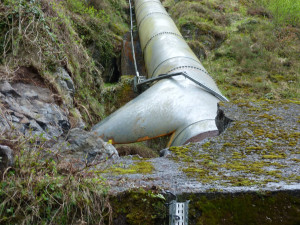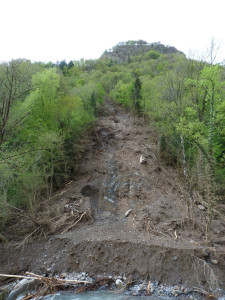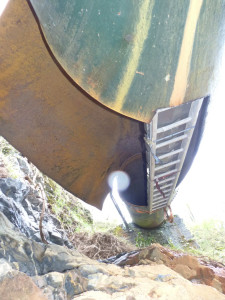A pressurised pipe (diameter : 1.2 m) burst around 8 am over a 3 to 200-m length downstream of the line valve. This tear occurred just upstream of a non-reinforced concrete pipe anchorage block, whose upper corner had ripped off heading downslope. The line valve automatically closed due to the pressure drop, yet the water remaining between the valve and the leak trickled onto a mountain descent. Sludge and ice jam accumulated around 2 bridges leading to a Seveso-rated aluminium plant, beneath the banks of the GAVE DE LESCUN watercourse. Rising waters wound up triggering the plant’s internal emergency plan at 9:30 am. All production units were shut down, with hazardous products being moved to an isolated spot and the plant operator installing protective cofferdams. Forty employees (excluding maintenance personnel) were evacuated. The inspector of classified facilities and the deputy prefect visited the site.
The pressurised pipe downstream of the leak and the power tunnel upstream of the line valve were drained at 10:30 am. Fire-fighters and a subcontracted company felled the trees and cleaned the watercourse. A press release was issued at 2 pm and the emergency plan lifted at 7 pm. Site activity resumed after 24 h of downtime. National Forestry Office employees, specialised in restoring mountainous terrain, verified slope stability. Pipe repair work and safety reinforcement lasted several months.
According to the hydroelectric plant operator, this break resulted from a complex sequence. Since 22nd April and without drawing attention, water injectors on one of the 2 Pelton turbines connected to the pipe had been inoperable (one due to the presence of fine sand). The other turbine’s injectors were thus responsible for all flow regulation and power production. The servomotor activating the idled injectors then received continuous commands to lower the load. However, an unexpected air intake on the hydraulic control circuit caused the slow and complete drainage of the servomotor positioned at a high point. On 26th April at 8:05 am, a fault alarm deactivated the generating set (network disconnection). The ensuing acceleration generated vibrations leading to abrupt closure of the injectors and the appearance of a water hammer spreading along the pipe (pressure measured at 56 bar, i.e. 176% of the design pressure).
This accident exposed the difficulties in relaying the operator’s alarm from the pressurised pipe to the aluminium plant. Moreover, the external shock resulting from the pipe break had not been anticipated in the plant’s internal emergency plan. The post-accident analysis highlighted the need for the plan to include a protocol for designating a substitute for the Director of Internal Operations to man the control post should the Director be called into the field during operations.






